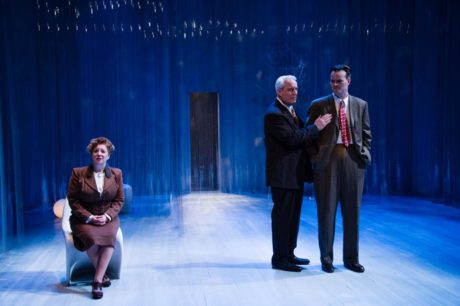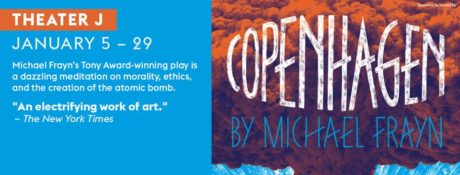Strange to watch a play unfold and wish that it did not feel so chillingly relevant. Or that the past it depicts never happened. Or that the moral and material uncertainty at its core did not portend a fearsome future. So it was on opening night of Theater J’s highly charged, highly skilled production of Michael Frayn’s 1998 Copenhagen—which at this moment in time plays like a minefield for the mind.
As the news cycle has recently had alarming reason to remind us, there are today, in the possession of some nine nations, more than 15,000 nuclear warheads. Enough to blow the world to kingdom come. What Frayn does in Copenhagen is to recollect that precarious instant in history when there were still none. No nation yet had one. But a race was on to invent one.

If this were myth, it would be like that fabled moment in Eden just before a bite into an apple introduced sin. But this is not myth; it actually happened: It’s the moment when physicists bit the bullet and introduced nuclear annihilation.
The explosive drama that is Copenhagen takes us back to that fateful juncture. The story is told in an unreal afterlife where three once-real-life people have gathered to unravel a mystery: Why did the German Nobel-winning physicist Werner Heisenberg come to Copenhagen in 1941 to visit Danish Nobel-winning physicist Niels Bohr, his friend and mentor, and Margrethe, Bohr’s wife? What exactly happened between them? What exactly was said?
The historical record draws an inconclusive blank, which Frayn fills in: Niels, Werner, and Margrethe talk to one another and to us and to themselves, and in doing so they parse the science and crises of conscience that converged in that mysterious meeting just prior to the prospect of nuclear holocaust.
The stakes are sky high. Heisenberg, who trained under Bohr in Denmark and now holds a university chair in Germany, may or may not be helping devise a nuclear bomb at Hitler’s behest. Bohr, who is half Jewish, lives in Nazi-occupied Denmark, his friendship with Heisenberg now strained by Hitler’s ruthless rise to power.
Bohr and Heisenberg piece together their conflicting memories and interpretations of that mysterious 1941 meeting. Margrethe Bohr’s memory adds weight, for she is both a reality check and an opinionated observer of Niels’s and Werner’s relationship. She gets not only the theoretical physics and realpolitiks but also the gendered drama in her husband’s filial feelings for his former mentee. Through Margrethe’s keen eyes, we see a father-son bond that at times absented Niels from her and the several real sons she bore him.
The way the play interweaves explanations of nuclear fission and evocations of war with dissection of tensions within a marriage over a friendship between two men—in crackling smart dialogue—makes for an extraordinarily provocative drama. And the cast on stage at Theater J does it every justice it deserves.
Michael Russotto’s Niels Bohr has both a professorial bearing and an avuncular inner glow. Tim Getman’s Werner Heisenberg exudes both ambitious earnestness and buoyant charm. They are especially appealing in their several buddy scenes, when they relive the beginnings of their brainy bond, the period in the 1920s when Heisenberg first studied with Bohr and together they conceived some of theoretical physics’s greatest hits: Heisenberg’s famous principle of uncertainty, Bohr’s theory of complementarity. The affection that arose between them becomes palpable in Russotto’s and Getman’s performance.
Next to Russotto’s and Getman’s towering stature, Sherri L. Edelen might appear a small soprano voice up against a booming bass and baritone. But Edelen’s Margrethe Bohr is fiercely focused and unyielding in her insistence on accurate recall. And her deadpan asides to the audience about the men land like truth bombs.

The script’s illuminating explications of how and why nuclear reactions work—hence how and why they can be weaponized—are in very plain English. Yet the play as written can seem a little heady and verge on austere. Moreover the text’s multiple layers of time and differing dimensions memory—the characters are dead after all, so Aristotelian unities be damned—can sometimes perplex. But Director Eleanor Holdridge has made several fascinating choices that have the salutary effect of both warming up the play and clarifying it. For instance there is a marked easygoingness in the acting that agreeably avoids the text’s temptation go oracular. And the distinctive stagecraft of the show lends intriguing support for the riveting storytelling.
Scenic Designer Luciana Stecconi’s striking blue-gray set is the interior of a massive cylinder whose walls are hung with clear vinyl strips—the sort used in doorways to walk-in freezers, except reaching to the fly space. Three white chairs, the only furnishings called for in the script, are modern molded white plastic. And lying about the stage are orbs that light up, as if atomic particles had fallen to the floor of a cyclotron. At times Holdridge has the actors slip through the vertical slats and play portions of scenes from the upstage side, as if in an unreal realm unlike the unreal realm centerstage. While sometimes distracting, these actors’ interactions with the set, wholly original to this production, do evoke the play’s multilayered unlocatedness and its quest for transparency.
Lighting Designer Andrew Cissna creates apt illusions in the way light reflects off those vinyl strips, as if particles and waves of light are in motion. And there are some stunning light cues that flood this cool cloud chamber with the sudden warmth of a shining sun.
Composer and Sound Designer Patrick Calhoun inserts lyrical musical passages between scenes—pianos, strings, wind chimes. Yet now and then there booms a distant detonation, audible yet almost subliminal, as if to keep us mindful of the end use of these end-of-days devices.
Hitler never got the atomic bomb. A conundrum of Copenhagen is whether Werner Heisenberg helped or hindered Hitler’s failed attempt to. But the United States did. And a corollary conundrum of Copenhagen is whether Niels Bohr aided and abetted Robert Oppenheimer and others at Los Alamos in that ignominious success.
Seventy two years ago—four years after the events of Copenhagen—the United States bombed Hiroshima and Nagasaki. More than any other play written since, Copenhagen explodes the moral enigma that ushered in the nuclear age. And right now it’s particularly urgent to see. Because more than any other play currently onstage in the nation’s Capitol, Theater J’s production exposes what led to the risk of recklessness that will soon accompany trigger-happy rage.
Running Time: Two hours 30 minutes, including one intermission.
Copenhagen plays through January 29, 2017, at Theater J at The Edlavitch DCJCC’s Aaron & Cecile Goldman Theater – 1529 16th Street, NW (16th and Q Streets), in Washington, DC. For tickets, call the box office at (202) 777-3210, or purchase them online.





